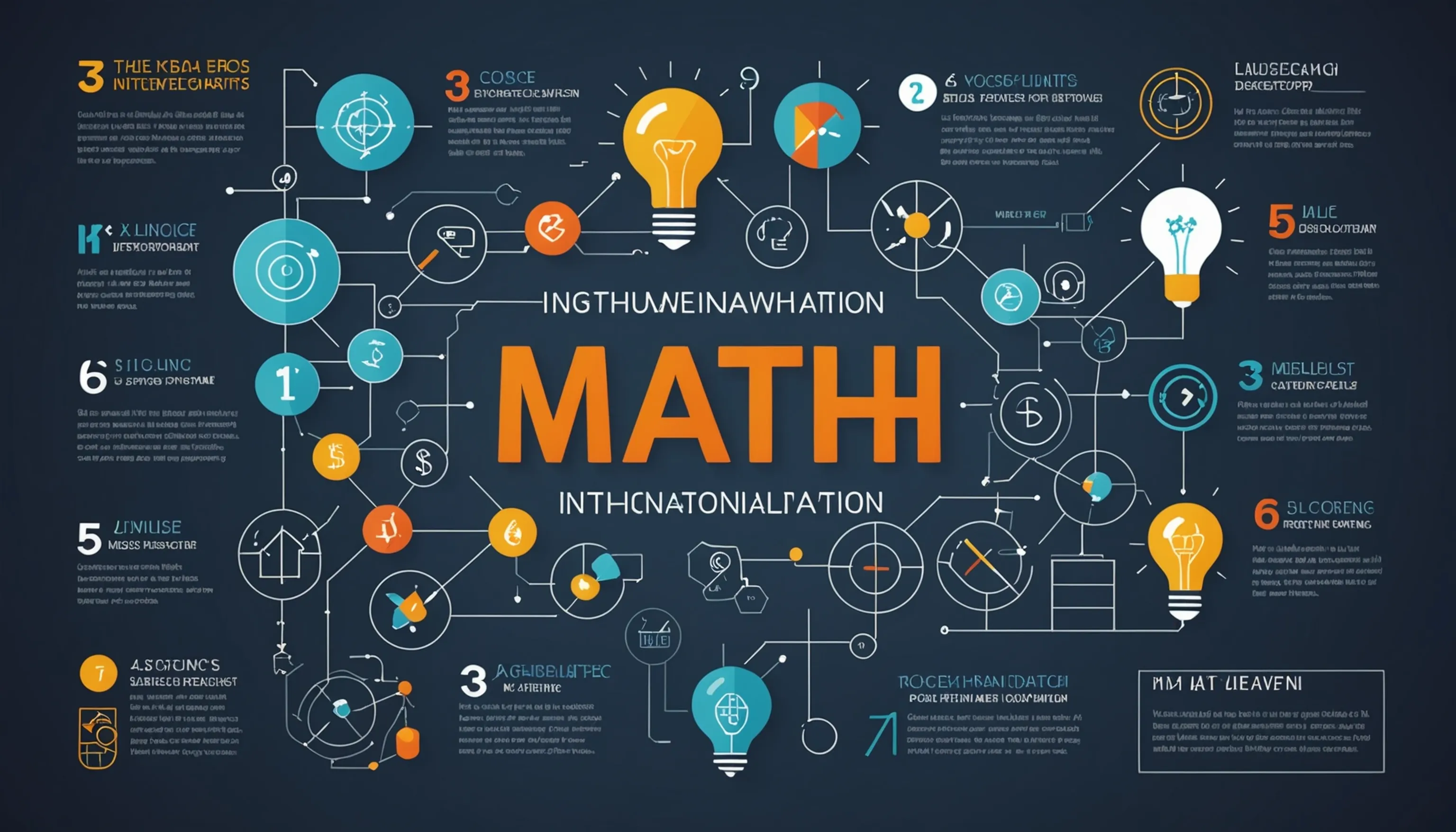The Role of Math in Innovation and Progress
 HvWHenry van Wagenberg
HvWHenry van Wagenberg
The Role of Math in Innovation and Progress
Mathematics plays a crucial role in innovation and progress across various fields. It serves as the foundation for technological advancements, enabling the development of complex algorithms and data analysis. Math helps in solving real-world problems by providing the tools necessary for precise measurements and modeling.
In science, math is essential for formulating theories and conducting experiments. It also drives engineering solutions, ensuring that structures are safe and efficient. Furthermore, mathematics influences finance and economics, guiding investments and economic forecasts. Ultimately, the application of math leads to improved outcomes in many aspects of modern life.
How Math Fuels Technological Advancements
Mathematics is often referred to as the language of science and technology, and its role in fueling technological advancements cannot be overstated. From the development of algorithms that power software applications to the intricate calculations involved in designing complex systems, math is at the core of innovation.
One key area where math plays a significant role is in data analysis. With the rise of big data, organizations rely on mathematical models to extract meaningful insights from vast amounts of information. Techniques such as statistics and probability help predict trends and inform decision-making processes.
Moreover, mathematics is essential in the field of artificial intelligence (AI) and machine learning. Algorithms used in AI rely heavily on linear algebra, calculus, and statistics to improve learning processes and enhance automation. This enables machines to make decisions based on patterns and data, leading to groundbreaking innovations in various sectors, including healthcare and finance.
In addition, mathematics underpins the principles of engineering, where precise calculations are needed to design everything from bridges to microchips. Engineers use mathematical modeling to test and validate their designs before implementation.
Furthermore, math is vital in the development of new technologies, such as renewable energy solutions. For instance, mathematical simulations can optimize the efficiency of solar panels and wind turbines, making them more viable alternatives to fossil fuels.
In summary, mathematics is a driving force behind technological advancements, providing the tools and frameworks necessary to innovate and create solutions for the future.
Mathematics in Scientific Research
Mathematics is an indispensable tool in scientific research, serving as the backbone for formulating hypotheses, designing experiments, and analyzing data. By providing a systematic approach to problem-solving, math enables scientists to quantify relationships, make predictions, and derive conclusions based on empirical evidence.
In fields such as physics and chemistry, mathematical equations describe fundamental principles that govern natural phenomena. For instance, Newton's laws of motion and Einstein's theory of relativity are grounded in mathematical formulations that allow researchers to predict the behavior of objects in motion. Similarly, in biology, mathematical models help researchers understand population dynamics and the spread of diseases.
Statistics, a branch of mathematics, is particularly vital in scientific research. It allows scientists to interpret experimental data, assess the reliability of their findings, and determine the significance of their results. By employing statistical methods, researchers can identify trends, make comparisons, and draw inferences that inform their understanding of complex systems.
Moreover, mathematics aids in the development of simulations and computational models that replicate real-world scenarios. These models are essential for studying systems that are difficult or impossible to observe directly, such as climate change or the behavior of subatomic particles.
In conclusion, mathematics is a cornerstone of scientific research, enhancing the rigor and reliability of findings across disciplines. Its role in formulating theories and analyzing data not only advances our understanding of the world but also drives innovation and discovery.

The Impact of Math on Engineering Solutions
Mathematics has a profound impact on engineering solutions, as it provides the essential tools for designing, analyzing, and optimizing structures and systems. Engineers rely on mathematical principles to ensure that their designs are safe, efficient, and effective in solving real-world problems.
One of the key areas where math is applied in engineering is in the field of structural engineering. Engineers use mathematical models to calculate loads, stresses, and material properties to ensure that structures like bridges, buildings, and towers can withstand environmental forces such as wind, earthquakes, and weight. By applying principles of calculus and algebra, they can predict how materials will behave under various conditions.
In addition, engineering disciplines such as electrical and mechanical engineering utilize mathematics to design circuits, control systems, and mechanical devices. For example, differential equations are used to model dynamic systems, helping engineers to analyze the behavior of systems over time.
Furthermore, mathematical optimization techniques are crucial in engineering for resource management and cost-effectiveness. Engineers use algorithms to find the best solutions to complex problems, such as minimizing waste in manufacturing processes or maximizing the efficiency of energy systems.
Moreover, advancements in computer technology have enabled engineers to use numerical methods and simulations to solve intricate mathematical problems that were previously impossible to tackle. This has led to innovative solutions in fields like aerospace, automotive, and environmental engineering.
In summary, math is fundamental to engineering solutions, driving innovation and ensuring that designs meet safety and performance standards.
Mathematics in Everyday Innovation
Mathematics is a driving force behind everyday innovation, influencing various aspects of our daily lives. From the technology we use to the products we consume, math plays a crucial role in enhancing efficiency and functionality. For instance, algorithms that power smartphone applications rely heavily on mathematical principles to deliver personalized experiences.
Additionally, mathematics is essential in optimizing transportation systems, ensuring that routes are efficient and minimizing travel time. In cooking, precise measurements and timing are rooted in math, allowing for consistent and successful recipes. Overall, math is woven into the fabric of innovation, shaping how we live and interact.
Math in Finance and Economics
Mathematics plays a pivotal role in the fields of finance and economics, providing the tools necessary for analyzing data, forecasting trends, and making informed decisions. Here are some key areas where math is applied in these fields:
- Financial Analysis: Mathematical models are used to assess the performance of investments. Techniques such as net present value (NPV) and internal rate of return (IRR) rely on mathematical calculations to evaluate potential returns.
- Risk Management: In finance, mathematics helps quantify risk. Statistical methods are employed to model uncertainty and calculate risk metrics, such as Value at Risk (VaR), which assists in determining the potential loss in investment portfolios.
- Econometric Modeling: Economists use mathematical equations to create models that describe economic relationships. These models can predict how changes in one variable, such as interest rates, affect other variables like inflation and unemployment.
- Market Analysis: Math is essential for analyzing market trends and consumer behavior. Techniques like regression analysis help identify patterns and correlations, aiding businesses in making strategic decisions.
Moreover, mathematical optimization techniques are crucial for allocating resources effectively. For instance, linear programming is used in production planning to minimize costs while maximizing output.
In summary, mathematics is fundamental in finance and economics, providing the necessary frameworks for analysis, decision-making, and strategic planning, ultimately driving economic growth and stability.

The Role of Math in Medicine and Healthcare
The role of mathematics in medicine and healthcare is increasingly vital, as it underpins numerous aspects of patient care, research, and health management. Here are several key areas where math plays a crucial role:
- Statistical Analysis: In medical research, statistics are essential for analyzing clinical trial data. Researchers use statistical methods to determine the efficacy of treatments and to assess the significance of their findings. For example, techniques like hypothesis testing and confidence intervals help evaluate whether a new drug is more effective than existing options.
- Modeling Disease Spread: Mathematics is used to model the spread of infectious diseases. Epidemiological models, such as the SIR model (Susceptible, Infected, Recovered), help predict how diseases spread through populations, guiding public health interventions.
- Medical Imaging: Techniques like MRI and CT scans rely on complex mathematical algorithms to create detailed images of the human body. These imaging techniques use mathematical transformations to reconstruct images from raw data, enabling accurate diagnosis.
- Dosing Calculations: In pharmacology, precise dosing calculations are critical for patient safety. Healthcare professionals use mathematical formulas to calculate the correct dosage based on a patient's weight, age, and medical condition.
Furthermore, healthcare analytics utilizes mathematical models to optimize resource allocation, improve patient outcomes, and streamline operations in hospitals.
In summary, mathematics plays a fundamental role in medicine and healthcare, enhancing diagnostic accuracy, informing treatment decisions, and improving overall health outcomes.
Mathematics in Environmental Solutions
Mathematics is essential in developing environmental solutions that address pressing global challenges. It provides the tools necessary for modeling complex systems, analyzing data, and predicting outcomes. Here are key areas where math contributes to environmental solutions:
- Climate Modeling: Mathematical models simulate climate systems to predict changes in temperature, precipitation, and extreme weather events. These models help policymakers understand potential impacts and develop mitigation strategies.
- Resource Management: Math is used to optimize the use of natural resources, such as water and energy. Techniques like linear programming help allocate resources efficiently while minimizing waste.
- Pollution Control: Statistical analysis is essential for monitoring pollution levels and assessing the effectiveness of environmental regulations. Math helps identify trends and sources of pollution, guiding remediation efforts.
In summary, mathematics plays a crucial role in creating effective environmental solutions, supporting sustainable practices and promoting a healthier planet.
Using Math to Address Climate Change
Mathematics is a critical tool in the fight against climate change, providing scientists and policymakers with the necessary frameworks to analyze data, model scenarios, and devise effective strategies. Here are several ways in which math is utilized to address climate change:
- Climate Modeling: Mathematical models simulate the Earth's climate system, allowing researchers to predict future climate scenarios based on various greenhouse gas emission trajectories. These models incorporate complex equations that account for atmospheric dynamics, ocean currents, and land-use changes, helping to forecast temperature rises and extreme weather patterns.
- Impact Assessment: Math is used to assess the potential impacts of climate change on ecosystems, agriculture, and human health. Statistical methods analyze historical data to identify trends and quantify risks associated with climate-related events, such as floods and droughts.
- Mitigation Strategies: Optimization techniques help develop strategies to reduce emissions and enhance sustainability. For instance, mathematical models can optimize energy use in buildings, identify the most efficient renewable energy sources, and inform transportation planning to minimize carbon footprints.
- Carbon Pricing: Econometric models assess the economic implications of carbon pricing mechanisms, guiding policymakers in creating incentives for reducing emissions and promoting cleaner technologies.
In conclusion, mathematics plays a vital role in addressing climate change by enabling researchers to understand complex systems, assess risks, and develop informed strategies for mitigation and adaptation.
Math in Sustainable Development Practices
Mathematics is a fundamental component of sustainable development practices, enabling effective planning, resource management, and decision-making across various sectors. Here are some key areas where math plays a crucial role:
- Resource Allocation: Mathematical optimization techniques help allocate resources efficiently in sustainable development projects. For instance, linear programming can determine the best combination of inputs, such as labor and materials, to minimize costs while maximizing output.
- Environmental Impact Assessment: Mathematical models are used to assess the environmental impacts of development projects. By analyzing data on emissions, resource consumption, and ecological effects, these models help identify potential risks and guide decision-makers towards more sustainable practices.
- Population and Economic Modeling: Math is essential for understanding the relationships between population growth, economic development, and resource use. Demographic and economic models help predict future trends and inform policies that promote sustainable growth.
- Monitoring and Evaluation: Statistical methods are employed to monitor the effectiveness of sustainable development initiatives. By analyzing data on key performance indicators, stakeholders can evaluate progress and make data-driven adjustments to improve outcomes.
In summary, mathematics is integral to sustainable development practices, providing the analytical tools needed to create effective strategies, assess impacts, and ensure that development meets the needs of the present without compromising future generations.
